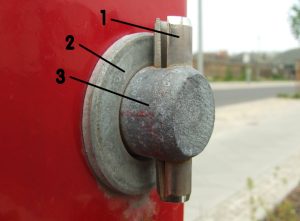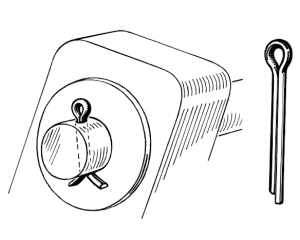Pins and Joints
One of the common types of joints used in machine design is the pin joint, which is a type of fastener that connects two or more parts by passing a cylindrical or tapered pin through holes in the parts. These are often the physical component that makes a revolute joint in a planar mechanism. The pin can be fixed or removable, depending on the application and the design requirements. Some of the advantages of pin joints are that they are simple, cheap, easy to assemble and disassemble, and can accommodate some misalignment and relative motion between the parts. Some of the design challenges for pin components include creating stress concentrations in the parts, requiring accurate hole alignment, and avoiding wear and corrosion.
When designing pin joints, some of the factors that need to be considered are the size, shape, material, and location of the pins, as well as the loading conditions and the service environment of the joint. The pins should be strong enough to resist shear and bending stresses, both from static load and fatigue loading (cycles of load). The pins should also have a suitable fit with the holes to prevent excessive clearance or interference, which can affect the performance and durability of the joint. The pins should be made of materials that are compatible with the parts they connect, and that have good resistance to wear and corrosion.
To specify a pin component from a supplier, some of the design parameters that need to be provided are:
- The type of pin (cylindrical, taper, or spring)
- The nominal diameter of the pin
- The length of the pin
- The tolerance and fit of the pin
- The material and surface finish of the pin
- The quantity and delivery time of the pin
Some of the common types of pins used in machine design are cylindrical pins, taper pins, and spring pins. Cylindrical pins have a constant diameter and are usually driven into reamed holes. They can be solid or hollow, depending on the weight and stiffness requirements. Taper pins have a slightly conical shape and are driven into tapered holes. They have a self-locking feature that prevents them from loosening due to vibration or thermal expansion. Spring pins are hollow cylindrical pins that have a slit along their length. They are inserted into slightly smaller holes and exert a radial force on the walls of the holes. They have a flexible and resilient nature that allows them to accommodate variations in hole size and alignment.


Some of the common applications of pin joints are cantilever joints, straddle mount joints, and pin and block joints. Cantilever joints are used to connect two parts that are perpendicular to each other, such as a lever and a shaft. The pin is inserted through one part and projects beyond it to support the other part. Straddle mount joints are used to connect two parts that are parallel to each other, such as two shafts or two plates. The pin is inserted through both parts and is supported by bearings or bushings at both ends. Pin and block joints are used to connect two parts that have relative sliding motion along a straight line, such as a piston rod and a crosshead. The pin is inserted through one part and slides in a slot or groove in the other part.
Various types of pins can be purchased from fastener suppliers and general suppliers. If purchasing many pins for a mass manufacturing context, it usually is more cost effective to order directly from a fastener supplier. For small lots, a general part supplier such as McMaster-Carr.
Look at the online catalog for McMaster-Carr for pins here:
For an example of a fastener supplier catalog, see Spirol products here:

